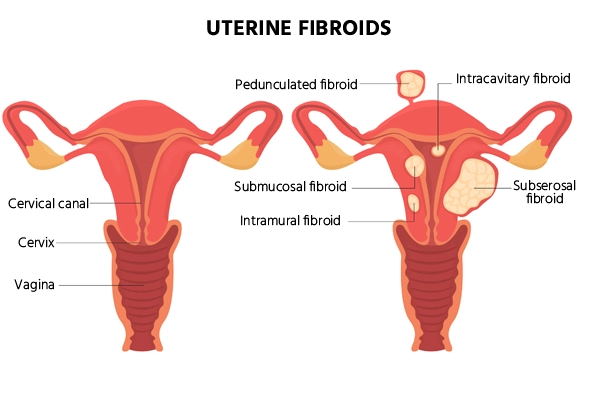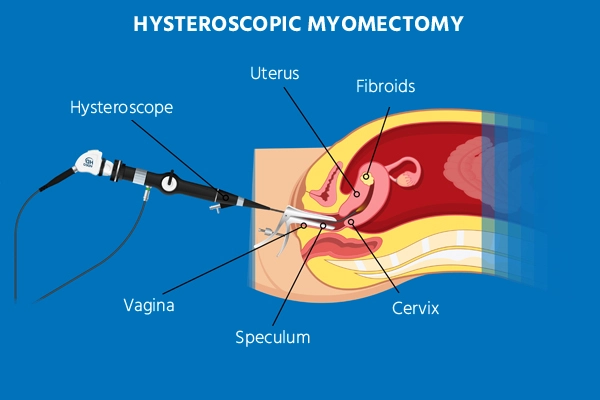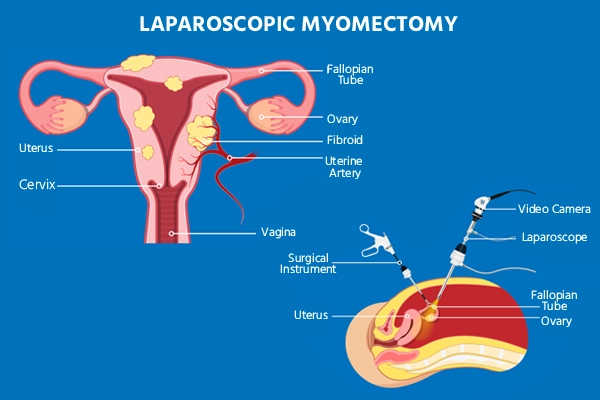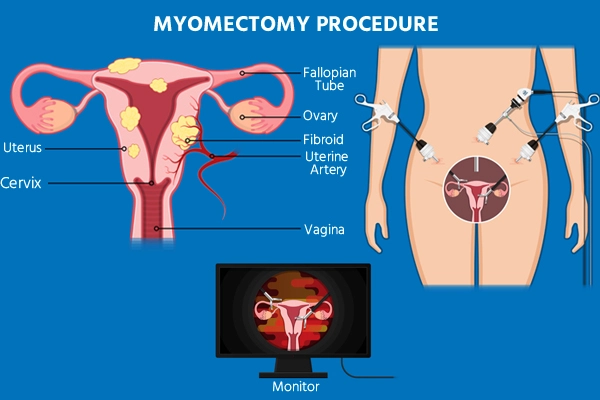What is Myomectomy?
Myomectomy is a surgical procedure designed to address a common gynecological concern: uterine fibroids. Uterine fibroids are non-cancerous growths that develop in the muscular wall of the uterus and can cause various symptoms, such as heavy menstrual bleeding, pelvic pain, and pressure on surrounding organs.
Unlike a hysterectomy, which involves the complete removal of the uterus, myomectomy focuses on the targeted removal of fibroids while preserving the uterus. This makes myomectomy an ideal choice for women who wish to retain their fertility or simply keep their uterus intact.
Myomectomy offers a range of benefits. It can alleviate the discomfort and symptoms associated with fibroids, improve fertility for those trying to conceive, and provide relief for women who wish to avoid a hysterectomy. Recovery times vary depending on the method used, with minimally invasive techniques generally leading to quicker recovery and less scarring.
As with any surgical procedure, myomectomy also carries some risks, such as bleeding, infection, or damage to surrounding organs. It's important for individuals considering myomectomy to consult with their healthcare provider to determine the best course of action based on their medical history, symptoms, and future reproductive goals.
What they do for Myomectomy Surgery Procedure
Abdominal Myomectomy (Open Surgery):
- Abdominal Myomectomy (Open Surgery):
- This traditional approach involves making a larger incision in the abdominal wall to access the uterus.
- It's typically used for larger fibroids or when there are multiple fibroids in various locations.
- The surgeon carefully removes the fibroids from the uterine wall and then sutures the uterus to repair any incisions.
- Laparoscopic Myomectomy:
- This minimally invasive technique involves making several small incisions in the abdominal wall.
- A laparoscope (a thin, lighted tube with a camera) is inserted through one of the incisions, allowing the surgeon to visualize the uterus on a monitor.
- Surgical instruments are inserted through the other incisions to remove the fibroids and suture the uterus as needed.
- Laparoscopic myomectomy results in smaller incisions, less scarring, and a shorter recovery time compared to open surgery.
- Robotic-Assisted Myomectomy:
- Similar to laparoscopic myomectomy, this technique uses a robotic surgical system to perform the procedure.
- The surgeon controls robotic arms equipped with surgical instruments to perform precise movements and remove the fibroids.
- Robotic-assisted myomectomy offers enhanced dexterity and visualization, potentially improving surgical outcomes.
- Hysteroscopic Myomectomy:
- This approach is used for fibroids that are located within the uterine cavity or protruding into it.
- A hysteroscope (a thin, lighted tube with a camera) is inserted through the vagina and cervix into the uterus.
- Surgical instruments are then used to remove or shave off the fibroids from the uterine lining.
Indications of Myomectomy Surgery Procedure
Myomectomy surgery procedure is indicated for various medical conditions and situations where uterine fibroids are causing significant symptoms or affecting a woman's reproductive health. Some of the common indications for myomectomy include:
- Symptomatic Fibroids: When fibroids cause symptoms such as heavy menstrual bleeding(menorrhagia), prolonged menstrual periods, pelvic pain, lower back pain, and pressure on the bladder or rectum, myomectomy can provide relief by removing the source of these symptoms.
- Infertility: Women experiencing difficulty conceiving due to fibroids may opt for myomectomy to improve their chances of pregnancy. Fibroids can sometimes interfere with the implantation of a fertilized egg or lead to miscarriages.
- Desire to Preserve Uterus: Myomectomy is chosen by women who want to retain their uterus for future reproductive or personal reasons as an alternative to a hysterectomy, which involves complete removal of the uterus.
- Large Fibroids: When fibroids are particularly large, causing discomfort or complications, myomectomy may be recommended to alleviate symptoms and prevent potential complications.
- Submucosal Fibroids: These fibroids grow within the uterine cavity and can cause heavy menstrual bleeding and fertility issues. Hysteroscopic myomectomy is often performed to remove them.
- Pedunculated Fibroids: These fibroids are attached to the uterus by a stalk and can sometimes cause pain or twisting. Surgical removal through myomectomy may be necessary.
- Pressure Symptoms: Fibroids pressing on nearby organs, such as the bladder or rectum, can lead to urinary frequency, constipation, or discomfort during intercourse. Myomectomy can relieve these symptoms.
- Recurrent Fibroids: In cases where fibroids regrow after a previous myomectomy, a repeat procedure may be considered.
- Unexplained Pelvic Pain: When pelvic pain is suspected to be caused by fibroids, a myomectomy might be recommended after a thorough evaluation and elimination of other potential causes.
Who will treat for Myomectomy Surgery
Myomectomy surgery is typically performed by a gynecologist, specifically a gynecologic surgeon who specializes in women's reproductive health and surgical procedures involving the female reproductive organs. Depending on the complexity of the case and the chosen surgical approach, different types of gynecologic surgeons may be involved. Here are the types of specialists who may be involved in treating myomectomy surgery:
- Gynecologist: A general gynecologist is trained to diagnose and manage a wide range of women's health issues, including uterine fibroids. They can perform myomectomies, particularly for straightforward cases or smaller fibroids.
- Gynecologic Surgeon: These are gynecologists who have undergone specialized training in surgical techniques related to the female reproductive system. They have expertise in performing various types of surgeries, including myomectomy, both through traditional open surgery and minimally invasive approaches.
- Reproductive Endocrinologist: Reproductive endocrinologists specialize in fertility issues. If a woman's primary concern is fertility preservation while treating fibroids, a reproductive endocrinologist may work alongside a surgeon to plan and execute the myomectomy.
- Minimally Invasive Surgeon: Surgeons with expertise in minimally invasive techniques, such as laparoscopic or robotic-assisted surgery, may perform myomectomies using these advanced approaches, which often lead to smaller incisions and faster recovery times.
- Urogynecologist: If fibroids are causing significant pressure on the bladder or rectum, a urogynecologist with expertise in pelvic floor disorders may collaborate with a gynecologic surgeon to address both the fibroids and associated pelvic organ issues.
- Hysteroscopic Surgeon: Hysteroscopic myomectomies, which involve removing fibroids from the uterine cavity through the cervix, are typically performed by gynecologists with expertise in hysteroscopic procedures.
How to prepare for Myomectomy Surgery
Preparing for myomectomy surgery involves several steps to ensure a smooth procedure and a successful recovery. Here's a general guideline on how to prepare for myomectomy surgery:
- Consultation and Evaluation:
- Schedule a consultation with your gynecologist or the surgeon who will perform the myomectomy.
- Discuss your medical history, current medications, allergies , and any pre-existing conditions.
- Undergo a thorough physical examination and possibly additional tests (such as imaging) to assess the size, location, and number of fibroids.
- Preoperative Instructions:
- Your surgeon will provide specific preoperative instructions, which may include guidelines on eating and drinking before the surgery and any necessary fasting.
- You might be advised to stop taking certain medications, such as blood-thinning medications, in the days leading up to the surgery.
- Smoking and Alcohol:
- If you smoke, consider quitting or at least reducing smoking before the surgery, as smoking can impair healing and increase the risk of complications.
- Limit alcohol consumption in the days leading up to the surgery.
- Nutrition and Hydration:
- Focus on a balanced diet rich in nutrients to support your body's healing process.
- Stay hydrated by drinking plenty of water.
- Arrange Support:
- Depending on the type of myomectomy and the expected recovery time, you might need assistance with daily activities during the initial recovery period. Arrange for someone to help you if needed.
- Packing for the Hospital:
- Pack any necessary items you'll need for your hospital stay, including comfortable clothing, toiletries, and any personal items that will help you feel at ease.
- Follow Fasting Instructions:
- If your surgeon instructs you to fast before the surgery, ensure that you adhere to the fasting guidelines to prevent complications during the procedure.
- Mental and Emotional Preparation:
- Understand the procedure, potential risks, and expected outcomes. Discuss any concerns or questions with your surgeon.
Prepare mentally and emotionally for the surgery by practising relaxation techniques or mindfulness.
- Arrangements for Transportation:
- Arrange for transportation to and from the hospital on the day of the surgery, as you may not be able to drive yourself after the procedure.
- Final Check-In with Medical Team:
- Follow up with your surgeon or medical team to confirm all preoperative instructions and address any last-minute questions or concerns.
Recovery after Myomectomy Surgery Procedure
Recovery after a myomectomy surgery procedure can vary based on the type of surgery performed (open, laparoscopic, robotic, hysteroscopic), the size and number of fibroids removed, and individual factors such as overall health and age. Here's a general overview of what you might expect during the recovery period:
- Immediate Postoperative Period (Hospital Stay):
- After the surgery, you will be monitored in the recovery area until you are awake and stable.
- Depending on the type of surgery and your overall condition, you might spend a night or more in the hospital.
Pain medication will be provided to manage any discomfort.
- First Few Days After Surgery:
- Pain and discomfort are common in the first few days. Your healthcare team will provide pain medication and instructions on how to manage pain.
You might experience fatigue, dizziness, or nausea due to the anesthesia and surgical stress.
- Follow any dietary guidelines provided by your healthcare team.
- First Two Weeks:
- You may need to take time off work or limit physical activities during this period to aid healing.
- Follow your surgeon's instructions on lifting restrictions, avoiding strenuous activities, and gradually increasing your activity level.
Take any prescribed medications as directed.
- 2-6 Weeks:
- Pain and discomfort usually improve during this time, although some residual soreness might persist.
- Gradually increase your activity level, but avoid heavy lifting, intense exercise, or activities that strain the abdominal muscles.
You might experience fatigue, which is normal as your body continues to recover.
- Long-Term Recovery:
- Over the next few months, your energy levels should return to normal, and any residual discomfort should gradually diminish.
- Your surgeon will schedule follow-up appointments to monitor your healing progress.
- If you have stitches, staples, or adhesive strips, they will be removed during a follow-up appointment.
- Your doctor will provide guidance on when you can resume more strenuous exercises, sexual activity, and other normal activities.
- Potential Complications to Watch For:
- While complications are rare, it's important to be aware of signs of infection (fever, increased pain, redness or discharge at incision sites), excessive bleeding, or other unusual symptoms. Contact your healthcare provider if you experience any concerning symptoms.
Lifestyle changes after Myomectomy Surgery Procedure
After undergoing a myomectomy surgery procedure, making certain lifestyle changes can aid in your recovery and overall well-being. Here are some recommended lifestyle adjustments to consider:
- Diet and Nutrition:
- Focus on a balanced diet rich in fruits, vegetables, lean proteins, and whole grains to support healing and boost your immune system.
Stay hydrated by drinking plenty of water.
- Incorporate foods that are high in fibre to help prevent constipation, a common issue after surgery.
- Physical Activity:
- Follow your surgeon's guidelines on physical activity and exercise.
- Start with gentle walking and gradually increase your activity level as you heal.
- Avoid strenuous exercises and heavy lifting during the initial weeks of recovery.
- Rest and Sleep:
- Get adequate rest to allow your body to heal properly.
- Prioritize sleep and consider adjusting your sleep position to avoid putting pressure on your surgical site.
- Medications:
- Take any prescribed medications as directed by your healthcare provider.
- If you're on pain medication, follow the recommended dosages and consult your doctor if you have concerns about side effects.
- Stress Management:
- Practice relaxation techniques, meditation, or deep breathing exercises to manage stress and promote healing.
- Avoid activities that may cause unnecessary stress during your recovery period.
- Clothing and Comfort:
- Wear loose and comfortable clothing to avoid putting pressure on the surgical area.
- Avoid tight belts or waistbands that might irritate incision sites.
- Alcohol and Smoking:
- If you smoke, consider quitting or reducing smoking, as it can hinder the healing process.
- Limit alcohol consumption, as excessive alcohol can interfere with healing and interact with medications.
- Work and Activities:
- Discuss with your surgeon when it's safe to return to work and resume normal activities.
- Gradually increase your activity level based on your doctor's recommendations.
- Listen to Your Body:
- Pay attention to your body's signals and adjust your activities accordingly. If something doesn't feel right or causes discomfort, consult your healthcare provider.




